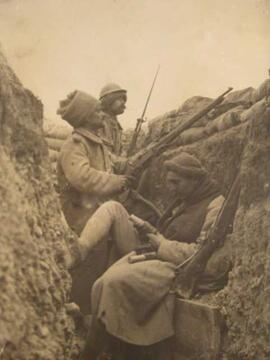SPEARS, Maj Gen Sir Edward Louis (1886-1974)
- SPEARS
- Collection
- 1851-[1974]
Papers, mainly on World War One compiled by Sir Edward Louis Spears, 1851-[1974]; notably including official World War One correspondence and telegrams, to GHQ, 1 Army, Gen Douglas Haig, Lt Gen Sir Henry Wilson and other officers, on infantry composition, munitions and artillery, lists of officers, colonial troops, morale, observation and intelligence gathering, the lessons of specific campaigns, the employment of tanks, casualties, prisoners of war (POWs), training, public opinion, operational orders for the French 6 Army by Gen Emile Fayolle, and more generally relations between the French and British armies, meetings, views and opinions by and concerning French C-in-C Henri-Philippe Petain, French Northern Army Commander, Ferdinand Foch, and Robert Nivelle, French C-in-C, 1916-1917, an interview with Georges Clemenceau, French Prime Minister from Nov 1917, US, Japanese, Greek and other correspondence and communications over Siberia, Japan, Finland, Bulgaria, and demands for independence by Eastern European peoples, US participation in the War and opinions on President Woodrow Wilson, Italian military offensives, precis of interviews with corps and army commanders, manuscript diary (1915), on the Russian civil war, post-war commerce, correspondence with Winston Leonard Spencer Churchill on post-war claims, the current political and military situation, especially in Russia, and Versailles peace conference papers, 1914-1920 (Spears Section 1); unpublished material collected by Spears for his publications on the War, including a report of events for 122 Bd, Royal Field Artillery (1916), detailed memoranda and correspondence concerning operations notably comprising copy letters between FM Sir Douglas Haig, Gen Nivelle, and others including to the Chief of the Imperial General Staff, and on reinforcements, the German postions, the Calais Agreement of February 1917, 1 and 3 Army operations, Franch Army mutinies in 1917, extracts from a diary covering the Battle of Arras, Apr 1917, the politics of liaison, interviews with French and British officers, including French C-in-C Henri-Philippe Petain and Lt Gen Sir Launcelot Edward Kiggell reflecting on strategic and other concerns, 1916-1938 (Spears Section 2); printed material by other authors on World War One used by Spears in his published studies, [1917-1964] (Spears Section 3); draft notes and chapters for Spears' published works on World War One, [1919-1974] (Spears Section 4); original source material and notes by Spears on the 1870 Siege of Paris, mainly rough notes and draft chapters on the Siege, original and copy letters from participants describing events and an exercise book containing lecture notes redating the Franco-Prussian War, [1851-1974] (Spears Section 5); newspaper reviews of Spears' books and critics' letters, 1930-1969 (Spears Section 6); material relating to a war memorial at Mons, 1936-1968 (Spears Section 7); personal papers, mainly articles on the life of Spears [1918-1974] (Spears Section 8), maps, principally of Arras, Bullecourt and Mons, during 1917 [1917]-1959 (Spears Section 9); photographic material, post cards and watercolour sketches, including of trenches, damaged buildings, troops and officers, and a visit to the Balkans in 1920, 1914-[1920] (Spears Section 10); photocopies of some items of Second World War material transferred to Churchill College, Cambridge, mainly on the fall of France, General de Gaulle, and French resistance, [1940-1943].
Spears, Sir Edward Louis, 1886-1974, 1st Baronet, Major General




